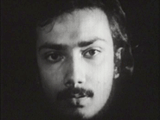In the book The Essential Mystery: The Major Filmmakers of Indian Art Cinema, John W. Hood proposes that the Bengali famine in 1943 was a watershed event that would deeply mark then 20 year old Mrinal Sen and lead to his politicization and involvement with the left-leaning Indian People’s Theatre Association. In hindsight, this convergence between personal and cultural history also seems to provide the underlying link between the overarching portrait of contemporary life in 1971 Kolkata with its prevailing images of the Naxalite insurgency, and the three self-contained, period stories presented in the film, each a crystallization of the spirit of the times and a harbinger of things to come. Framed through the perspective of a doomed, anonymous 20 year old militant student whose restless spirit hovers over the city to confront its legacy of poverty, underprivilege, and cruelty, each story exposes society’s complicity in the unraveling of a natural crisis into human catastrophe.
The first installment, 1933, based on Manik Bandyopadhyay’s The Right to Suicide, underscores the everyday realities of life in the flood-prone city, where life remains in a state of transience, caught in a perpetual cycle of construction and destruction, transformation and decay. Capturing an impoverished family’s futile attempts to weather the monsoon rains from their dilapidated home, as the head of the family (Satya Bannerjee) increasingly shows his frustration and helplessness by lashing out at his adolescent daughter and a stray dog, 1933 illustrates the inhumanity imposed by an entrenched caste system that continues to reinforce arbitrary power structures even within the inescapable reality of impotence and destitution, a corrosive cycle that perpetuates a sense of entitlement (that, in turn, leads to complacency in its illusion of expected privilege) and oppression of the weak.
Adapted from Prabodh Sanyal’s The Disgraced, the second episode, 1943 examines the wide-reaching toll of the famine, from an early montage of desperate villagers converging in the already overcrowded city to beg for food, to a day in the life portrait within the relative comfort of a middle class family, where a young widow, Shobhona (Madhabi Mukherjee) struggles to support her mother and younger siblings. Relocating to Kolkata after giving up custody of her son (having moved into an apartment building under murky arrangements with the owner), the family is compelled to face their degraded circumstances when a cousin, on his way to a new civil service job in Delhi, pays an unexpected visit. Contrasting fond memories of their idyllic lives in the village against the austerity of their new life in Kolkata, Sen reinforces the idea of the famine as a juncture of paradise lost, a complete rupture from the past. Moreover, in confronting the mother’s instigations to solicit money from her neighbor (by sending her teenaged daughter to run errands for him), and her son (by goading him to exploit his employment at a tea shop), Sen parallels the family’s decline in status with their moral prostitution (a theme that also surfaces in Satyajit Ray’s Distant Thunder, where the erosion of social class is created by the commonality of despair.
The intersection between (artificially created) class disparity and food shortage also provides the framework for 1953 in its tale of two cities – one, propelled by urban development and agricultural reforms stemming from Jawaharlal Nehru’s five-year plan, the other, relegated to the sidelines of economic transformation. Based on Samaresh Basu’s The Smuggler, the film challenges the notion of national unity that the consolidation of the railways symbolizes in its segregation of passengers between the working class and the poor, uneducated “backwards classes” who stow away on trains to panhandle, or smuggle food through the porous borders of (then) East Pakistan for sale in the drought affected villages. Devolving into a symbolic class war between the privileged passengers (as embodied by a health conscious traveler who epitomizes the Darwinian capitalist model: survival of the fittest) and the young, impoverished smugglers, Sen alludes to the perils of complacency and displaced retaliation (a theme that also recalls the father’s impotent rage in 1933) that also underlies the anonymous stranger’s social indictment. Revisiting the transgressions of the past, the disembodied stranger becomes the nation’s figurative collective consciousness, confronting society’s tendency to reconstitute human suffering as distant histories removed from everyday reality. Culminating with the portrait of contemporary Kolkata in which a politician (Ajitesh Bannerjee) hypocritically expresses his concern during a lavish dinner party over the flood of refugees arriving into the city from Bangladesh as a result of the war for independence, the image of famine victims repurposed as wall art encapsulates the aestheticization of tragedy as abstract spectacle, and humanity’s moral imperative to reclaim art from its bastardized role as status symbol to its ideological origins as an instrument of social revolution.
© Acquarello 2008. All rights reserved.
